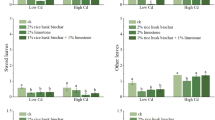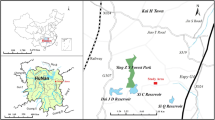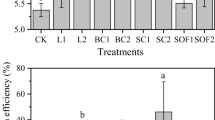Abstract
The effectiveness of water management in reducing cadmium (Cd) accumulation in rice grain has mainly been investigated in slightly and moderately contaminated soils but seldom in heavily contaminated soils. In addition, how soil physicochemical properties influence the effectiveness of water management merits investigation. In this study, a pot experiment was performed using six soils of slight (S1), moderate (S2–S5), and heavy (S6) Cd contamination levels and of different properties. Three water managements, flooding until full tillering (W1), flooding until full tillering and reflooding after 7–10-day drying (W2), and continuous flooding without drying (W3), were implemented for each soil. Cadmium content in rice grain was significantly decreased (by 60% on average) in W2 and further decreased (by 82% on average) in W3 as compared with W1 in all the six soils. Grain Cd contents in the W3 treatments were decreased to below the Chinese food safety standard of 0.2 mg kg−1 in all the six soils except in S6 (0.36 mg kg−1). For all the three water management regimes, the lowest grain Cd content was observed in S3 which had high contents of organic matter, sulfur, and iron. The results indicate that extended flooding can effectively decrease rice grain Cd accumulation in soils of various contamination levels especially those rich in organic matter, sulfur, and iron. But for heavily contaminated soils, water management may need to combine with other approaches to further decrease grain Cd content to meet food safety standard.



Similar content being viewed by others
Data Availability
Not applicable.
Code Availability
Not applicable.
References
Arao, T., Kawasaki, A., Baba, K., Mori, S., & Matsumoto, S. (2009). Effects of water management on cadmium and arsenic accumulation and dimethylarsinic acid concentrations in Japanese rice. Environmental Science & Technology, 43, 9361.
Cao, F., Cai, Y., Liu, L., Zhang, M., He, X., Zhang, G., & Wu, F. (2015). Differences in photosynthesis, yield and grain cadmium accumulation as affected by exogenous cadmium and glutathione in the two rice genotypes. Plant Growth Regulation, 75, 715.
Chen, H., Zhang, W., Yang, X., Wang, P., McGrath, S. P., & Zhao, F. J. (2018). Effective methods to reduce cadmium accumulation in rice grain. Chemosphere, 207, 699.
Cui, Y. J., Zhu, Y. G., Smith, F. A., & Smith, S. E. (2004). Cadmium uptake by different rice genotypes that produce white or dark gains. Journal of Environmental Sciences, 16, 962.
Daum, D., Bogdan, K., Schenk, M. K., Merkel, D. (2001). Influence of the field water management on accumulation of arsenic and cadmium in paddy rice, Plant nutrition. Springer, pp. 290-291.
Deering, K. E., Callan, A. C., Prince, R. L., Lim, W. H., Thompson, P. L., Lewis, J. R., Hinwood, A. L., & Devine, A. (2018). Low-level cadmium exposure and cardiovascular outcomes in elderly Australian women: a cohort study. International Journal of Hygiene and Environmental Health, 221, 347.
Fahad, S., Hussain, S., Khan, F., Wu, C., Saud, S., Hassan, S., Ahmad, N., Gang, D., Ullah, A., & Huang, J. (2015). Effects of tire rubber ash and zinc sulfate on crop productivity and cadmium accumulation in five rice cultivars under field conditions. Environmental Science and Pollution Research, 22, 12424.
Fasahat, P. (2015). Recent progress in understanding cadmium toxicity and tolerance in rice. Emirates Journal of Food and Agriculture, 27, 94.
Guo, F., Ding, C., Zhou, Z., Huang, G., & Wang, X. (2018). Effects of combined amendments on crop yield and cadmium uptake in two cadmium contaminated soils under rice-wheat rotation. Ecotoxicology and Environmental Safety, 148, 303.
He, J. Y., Zhu, C., Ren, Y. F., Yan, Y. P., Cheng, C., Jiang, D. A., & Sun, Z. X. (2008). Uptake, subcellular distribution, and chemical forms of cadmium in wild-type and mutant rice. Pedosphere, 18, 371.
Hirzel, J., Retamal-Salgado, J., Walter, I., & Matus, I. (2019). Fixation coefficient and soil residual effect of cadmium application on three biannual crop rotations at four locations in Chile. Journal of Soil Science and Plant Nutrition, 19, 450–462.
Houba, V. J. G., Temminghoff, E. J. M., Gaikhorst, G. A., & van Vark, W. (2000). Soil analysis procedures using 0.01 M calcium chloride as extraction reagent. Communications in Soil Science and Plant Analysis, 31, 1299.
Hu, P. J., Huang, J. X., Ouyang, Y. N., Wu, L. H., Song, J., Wang, S. F., Li, Z., Han, C. L., Zhou, L. Q., Huang, Y. J., Luo, Y. M., & Christie, P. (2013a). Water management affects arsenic and cadmium accumulation in different rice cultivars. Environmental Geochemistry and Health, 35, 767.
Hu, P. J., Li, Z., Yuan, C., Ouyang, Y. N., Zhou, L. Q., Huang, J. X., Huang, Y. J., Luo, Y. M., Christie, P., & Wu, L. H. (2013b). Effect of water management on cadmium and arsenic accumulation by rice (Oryza sativa L.) with different metal accumulation capacities. Journal of Soils and Sediments, 13, 916.
Hu, P. J., Ouyang, Y. N., Wu, L. H., Shen, L. B., Luo, Y. M., & Christie, P. (2015). Effects of water management on arsenic and cadmium speciation and accumulation in an upland rice cultivar. Journal of Environmental Sciences, 27, 225.
Hu, Y. A., Cheng, H. F., & Tao, S. (2016). The challenges and solutions for cadmium-contaminated rice in China: A critical review. Environment International, 2016, 515.
Hu, Z., Wang, Y., Fang, Z., Shi, G., Lou, L., Ren, K., & Cai, Q. (2020). Italian ryegrass-rice rotation system for biomass production and cadmium removal from contaminated paddy fields. Journal of Soils and Sediments, 20, 874.
Huang, D., Xi, L., Yang, L., Wang, Z., & Yang, J. (2008). Comparison of agronomic and physiological traits of rice genotypes differing in cadmium-tolerance. Acta Agronomica Sinica, 34, 809.
Jing, F., Chen, C., Chen, X., Liu, W., Wen, X., Hu, S., Yang, Z., Guo, B., Xu, Y., & Yu, Q. (2020). Effects of wheat straw derived biochar on cadmium availability in a paddy soil and its accumulation in rice. Environmental Pollution, 257, 113592.
Juang, K. W., Ho, P. C., & Yu, C. H. (2012). Short-term effects of compost amendment on the fractionation of cadmium in soil and cadmium accumulation in rice plants. Environmental Science and Pollution Research, 19, 1696.
Kanu, A. S., Ashraf, U., Mo, Z., Fuseini, I., Mansaray, L. R., Duan, M., Pan, S., & Tang, X. (2017). Cadmium uptake and distribution in fragrant rice genotypes and related consequences on yield and grain quality traits. Journal of Chemistry, 2017, 1405878.
Li, Q., Guo, J., Zhang, X., Yu, H., Huang, F., Zhang, L., Zhang, M., & Li, T. (2019). Changes of non-protein thiols in root and organic acids in xylem sap involved in cadmium translocation of cadmium-safe rice line (Oryza sativa L.). Plant and Soil, 439, 475.
Liang, Y., Lei, L., Nilsson, J., Li, H., Nordberg, M., Bernard, A., Nordberg, G. F., Bergdahl, I. A., & Jin, T. (2011). Renal function after reduction in cadmium exposure: An 8-year follow-up of residents in cadmium-polluted areas. Environmental Health Perspectives, 120, 223.
Liao, G. J., Wu, Q. H., Feng, R. W., Guo, J. K., Wang, R. G., Xu, Y. M., Ding, Y. Z., Fan, Z. L., & Mo, L. Y. (2016). Efficiency evaluation for remediating paddy soil contaminated with cadmium and arsenic using water management, variety screening and foliage dressing technologies. Journal of Environmental Management, 170, 116.
Lin, H., Zhang, X. H., Liang, Y. P., Liu, J., & Huang, H. T. (2014). Enrichment of heavy metals in rice under combined pollution of Cu, Cr, Ni and Cd. Ecology Environmental Science, 23, 1991.
Liu, J., Qian, M., Cai, G., Yang, J., & Zhu, Q. (2007). Uptake and translocation of Cd in different rice cultivars and the relation with Cd accumulation in rice grain. Journal of Hazardous Materials, 143, 443.
Loeppert, R. L., & Inskeep, W. P. (1996). Iron. In D. L. Sparks, A. L. Page, P. A. Helmke, & R. H. Loeppert (Eds.), Methods of soil analysis. Part 3. Chemical methods. Soil Science Society of America.
Lu, Y., Song, S., Wang, R., Liu, Z., Meng, J., Sweetman, A. J., Jenkins, A., Ferrier, R. C., Li, H., Luo, W., & Wang, T. (2015). Impacts of soil and water pollution on food safety and health risks in China. Environment International, 77, 5.
Ministry of Ecology and Environment of the People’s Republic of China (MEEPRC). (2018). GB 15618–2018. Soil Environmental quality-risk control standard for soil contamination of agricultural land, MEEPRC.
Ministry of Environmental Protection/Ministry of Land and Resources (MEP/MLR). (2014). The report on the national soil contamination survey (in Chinese). http://www.gov.cn/foot/site1/20140417/782bcb88840814ba158d01.pdf.
Mu, T. T., Wu, T. Z., Zhou, T., Li, Z., Ouyang, Y. N., Jiang, J. P., Zhu, D., Hou, J. Y., Wang, Z. Y., Luo, Y. M., Christie, P., & Wu, L. H. (2019). Geographical variation in arsenic, cadmium, and lead of soils and rice in the major rice producing regions of China. Science of the Total Environment, 677, 373.
Qian, Y., Chen, C., Zhang, Q., Li, Y., Chen, Z., & Li, M. (2010). Concentrations of cadmium, lead, mercury and arsenic in Chinese market milled rice and associated population health risk. Food Control, 21, 1757.
Smolders, E., & Mertens, J. (2013). Cadmium. In B. J. Alloway (Ed.), Heavy metals in soils: Trace metals and metalloids in soils and their bioavailability (pp. 283–311). Springer Netherlands.
Song, Y., Wang, Y. B. N., Mao, W. F., Sui, H. X., Yong, L., Yang, D. J., Jiang, D. G., Zhang, L., & Gong, Y. Y. (2017). Dietary cadmium exposure assessment among the Chinese population. PLoS One, 12, e0177978.
Sun, L. M., Zheng, M. M., Liu, H. Y., Peng, S. B., Huang, J. L., Cui, K. H., & Nie, L. X. (2014). Water management practices affect arsenic and cadmium accumulation in rice grains. The Scientific World Journal, 2014, 596438.
Wang, X., Zeng, X., Liu, C., Li, F., Xu, X., & Lv, Y. (2016). Heavy metal contaminations in soil-rice system: Source identification in relation to a sulfur-rich coal burning power plant in Northern Guangdong Province, China. Environmental Monitoring and Assessment, 188, 460.
Wang, J., Wang, P. M., Gu, Y., Kopittke, P. M., Zhao, F. J., & Wang, P. (2019a). Iron-manganese (Oxyhydro) oxides, rather than oxidation of sulfides, determine mobilization of cd during soil drainage in paddy soil systems. Environmental Science & Technology, 53, 2500.
Wang, P., Chen, H., Kopittke, P. M., & Zhao, F. J. (2019b). Cadmium contamination in agricultural soils of China and the impact on food safety. Environmental Pollution, 249, 1038.
Yang, Q. W., Lan, C. Y., Wang, H. B., Zhuang, P., & Shu, W. S. (2006). Cadmium in soil-rice system and health risk associated with the use of untreated mining wastewater for irrigation in Lechang, China. Agricultural Water Management, 84, 147–152.
Ye, X. X., Li, H. Y., Ma, Y. B., Wu, L., & Sun, B. (2014). The bioaccumulation of Cd in rice grains in paddy soils as affected and predicted by soil properties. Journal of Soils and Sediments, 14, 1407.
Yu, H., Wang, J. L., Fang, W., Yuan, J. G., & Yang, Z. Y. (2006). Cadmium accumulation in different rice cultivars and screening for pollution-safe cultivars of rice. Science of The Total Environment., 370(2-3), 302–309.
Yu, H., Guo, J., Li, Q., Zhang, X., Huang, H., Huang, F., Yang, A., & Li, T. (2020). Characteristics of cadmium immobilization in the cell wall of root in a cadmium-safe rice line (Oryza sativa L.). Chemosphere, 241, 125095.
Yuan, C., Li, F., Cao, W., Yang, Z., Hu, M., & Sun, W. (2019). Cadmium solubility in paddy soil amended with organic matter, sulfate, and iron oxide in alternative watering conditions. Journal of Hazardous Materials, 378, 120672.
Zhang, X., Chen, D., Zhong, T., Zhang, X., Cheng, M., & Li, X. (2015). Assessment of cadmium (Cd) concentration in arable soil in China. Environmental Science and Pollution Research, 22, 4932.
Zhang, D., Du, G., Chen, D., Shi, G., Rao, W., Li, X., Jiang, Y., Liu, S., & Wang, D. (2019). Effect of elemental sulfur and gypsum application on the bioavailability and redistribution of cadmium during rice growth. Science of the Total Environment, 657, 1460.
Zhou, H., Zeng, M., Zhou, X., Liao, B. H., Peng, P. Q., Hu, M., Zhu, W., Wang, Y. J., & Zou, Z. J. (2015). Heavy metal translocation and accumulation in iron plaques and plant tissues for 32 hybrid rice (Oryza sativa L.) cultivars. Plant and Soil, 386, 317.
Zhuang, P., Zou, B., Li, N. Y., & Li, Z. A. (2009). Heavy metal contamination in soils and food crops around Dabaoshan mine in Guangdong, China: Implication for human health. Environmental Geochemistry and Health, 31, 707.
Acknowledgement
This work was co-funded by the National Natural Science Foundation of China (41271266, 41877334), the Science and Technology Program of Guangzhou (201903010012), and the Guangdong Basic and Applied Basic Research Foundation (2019A1515012177).
Funding
This work was co-funded by the National Natural Science Foundation of China (41271266, 41877334), the Science and Technology Program of Guangzhou (201903010012), and the Guangdong Basic and Applied Basic Research Foundation (2019A1515012177).
Author information
Authors and Affiliations
Corresponding authors
Ethics declarations
Conflicts of Interest
The authors declare no competing interests.
Additional information
Publisher’s Note
Springer Nature remains neutral with regard to jurisdictional claims in published maps and institutional affiliations.
Rights and permissions
About this article
Cite this article
Lu, W., Li, D., Liu, Y. et al. Effectiveness of Water Management in Producing Cadmium-Safe Rice in Soils of Different Contamination Levels and Physicochemical Properties. Water Air Soil Pollut 232, 154 (2021). https://doi.org/10.1007/s11270-021-05112-4
Received:
Accepted:
Published:
DOI: https://doi.org/10.1007/s11270-021-05112-4




